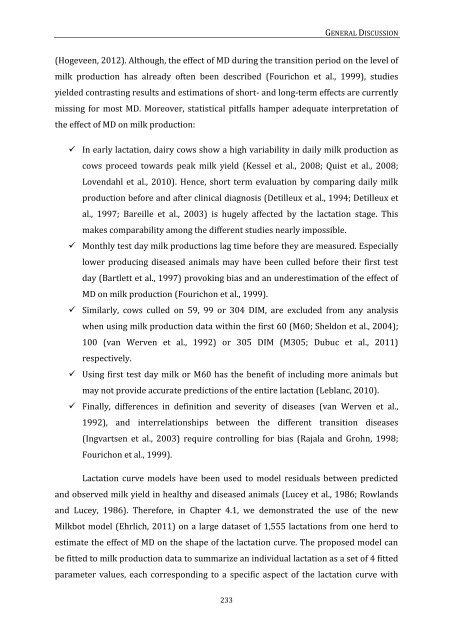view - Department of Reproduction, Obstetrics and Herd Health
view - Department of Reproduction, Obstetrics and Herd Health
view - Department of Reproduction, Obstetrics and Herd Health
You also want an ePaper? Increase the reach of your titles
YUMPU automatically turns print PDFs into web optimized ePapers that Google loves.
GENERAL DISCUSSION<br />
(Hogeveen, 2012). Although, the effect <strong>of</strong> MD during the transition period on the level <strong>of</strong><br />
milk production has already <strong>of</strong>ten been described (Fourichon et al., 1999), studies<br />
yielded contrasting results <strong>and</strong> estimations <strong>of</strong> short- <strong>and</strong> long-term effects are currently<br />
missing for most MD. Moreover, statistical pitfalls hamper adequate interpretation <strong>of</strong><br />
the effect <strong>of</strong> MD on milk production:<br />
In early lactation, dairy cows show a high variability in daily milk production as<br />
cows proceed towards peak milk yield (Kessel et al., 2008; Quist et al., 2008;<br />
Lovendahl et al., 2010). Hence, short term evaluation by comparing daily milk<br />
production before <strong>and</strong> after clinical diagnosis (Detilleux et al., 1994; Detilleux et<br />
al., 1997; Bareille et al., 2003) is hugely affected by the lactation stage. This<br />
makes comparability among the different studies nearly impossible.<br />
Monthly test day milk productions lag time before they are measured. Especially<br />
lower producing diseased animals may have been culled before their first test<br />
day (Bartlett et al., 1997) provoking bias <strong>and</strong> an underestimation <strong>of</strong> the effect <strong>of</strong><br />
MD on milk production (Fourichon et al., 1999).<br />
Similarly, cows culled on 59, 99 or 304 DIM, are excluded from any analysis<br />
when using milk production data within the first 60 (M60; Sheldon et al., 2004);<br />
100 (van Werven et al., 1992) or 305 DIM (M305; Dubuc et al., 2011)<br />
respectively.<br />
Using first test day milk or M60 has the benefit <strong>of</strong> including more animals but<br />
may not provide accurate predictions <strong>of</strong> the entire lactation (Leblanc, 2010).<br />
Finally, differences in definition <strong>and</strong> severity <strong>of</strong> diseases (van Werven et al.,<br />
1992), <strong>and</strong> interrelationships between the different transition diseases<br />
(Ingvartsen et al., 2003) require controlling for bias (Rajala <strong>and</strong> Grohn, 1998;<br />
Fourichon et al., 1999).<br />
Lactation curve models have been used to model residuals between predicted<br />
<strong>and</strong> observed milk yield in healthy <strong>and</strong> diseased animals (Lucey et al., 1986; Rowl<strong>and</strong>s<br />
<strong>and</strong> Lucey, 1986). Therefore, in Chapter 4.1, we demonstrated the use <strong>of</strong> the new<br />
Milkbot model (Ehrlich, 2011) on a large dataset <strong>of</strong> 1,555 lactations from one herd to<br />
estimate the effect <strong>of</strong> MD on the shape <strong>of</strong> the lactation curve. The proposed model can<br />
be fitted to milk production data to summarize an individual lactation as a set <strong>of</strong> 4 fitted<br />
parameter values, each corresponding to a specific aspect <strong>of</strong> the lactation curve with<br />
233









